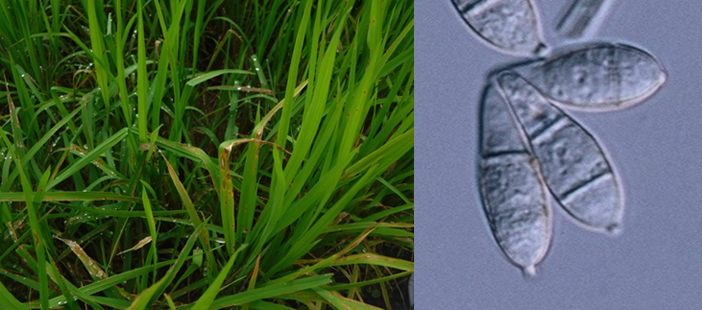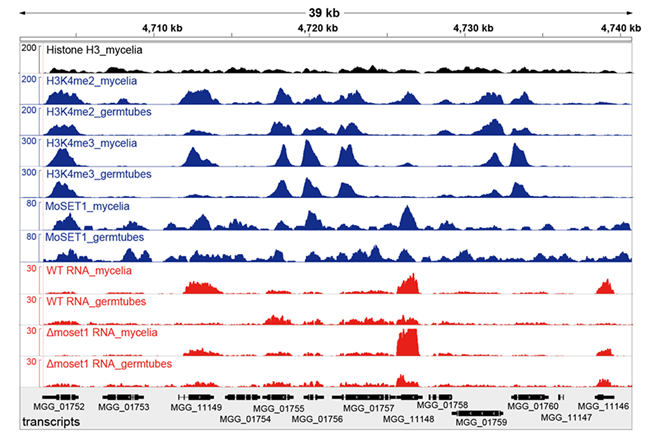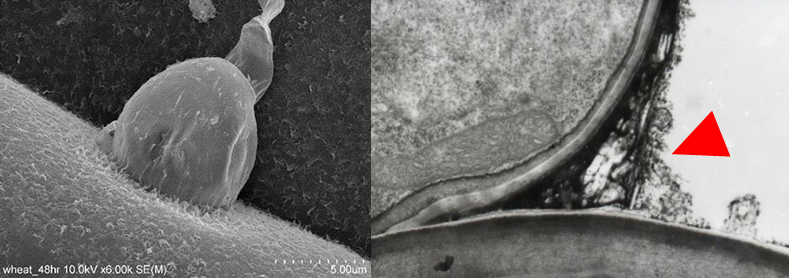Division of Plant Health, Environment and Biotechnology
Cell Function and Structure
In this lab, we study plant-microbe interactions with a particular interest in cytology and epigenetics of fungal pathogens. We elucidate various aspects of plant-microbe interactions such as adhesion of a fungal pathogen to the surface of a plant leaf, cell differentiation of fungal pathogens during infection, and plant defense mechanisms against pathogens. The research and educational activities are aimed at elucidation of the underlying molecular mechanisms and application of research findings for human benefit. Especially, we also try to develop an environmental friendly measure of disease protection such as biological control.
We focused on the causal agent of blast disease of gramineous plants, Pyricularia oryzae. Its spore is very small ca. 30×10 μm, and elaborates an appressorium after germination on the host plant to penetrate into a host cell.

Disease symptoms (left) and spores of Pyricularia oryzae (right).
- Epigenetic genome regulation in phytopathogenic fungi
During the course of infection, phytopathogenic fungi including the blast fungus, Pyricularia oryzae, form various morphologically and functionally different cells such as spores, germination tubes, and appressoria. Such cell differentiation during infection is assumed to be controlled by epigenetic regulation such as histone modifications and DNA methylation. We are focusing on this point and performing research in details. In the figure below, we investigated changes in the levels of H3K4me2 and H3K4me3, which are typical epigenetic marks on histone, during the course of infection, referring to those of RNA expression. In addition, we are also working on epigenetic regulation of transposable elements that can be a cause of a new fungal pathotype by generating genetic variations in the host fungal genome.

Dynamic changes in histone modifications (blue) and RNA transcription (red) during appressorium formation in Pyricularia oryzae
- Elucidation of infection strategies based on morphological study
Fungal adhesion to host cells is an initial important step to establish infection, which is considered to be a universal mechanism across plant pathogenic fungi. The fungal surface is covered with de novo synthesized compounds collectively called the extracellular matrix, which might be involved in host adhesion. After the establishment of host adhesion, the germ tube differentiates into appressorium. We try to elucidate molecular mechanisms of infection process.

Appressorium on the wheat leaf (left) and extracellular matrix (right).
- Development of novel disease protection measures
(1)Detachment action
Based on our finding that adhesion is one of the pathogenicity factors, we try to develop novel biological control. The glycoproteinase family was able to degrade fungal extracellular matrix. Therefore, we try to utilize gelatinolytic bacteria to detach fungal pathogen from the leaf.

The glycoproteinases (e.g., collagenase and gelatinase) were able to degrade extracellular matrix and
detach fungal pathogen from host plant (left).
We try to develop novel biological control by detachment action of the pathogen (right).
(2)Virocontrol (Virological Control)
Certain mycoviruses cause hypovirulence in fungal pathogens. We try to develop a biological control strategy by utilizing a hypovirulent mycovirus, virocontrol.

Certain mycoviruses affect virulence of phytopathogenic fungi (left).
We try to introduce an effective mycovirus to a fungal pathogen for virocontrol (right).
Cell Function and Structure Web Site(
facebook)




